American bobtail
| American bobtail | |||
|---|---|---|---|
|
|||
| Fur length: | Shorthair / semi-longhair cat | ||
| Weight: | Male : 3.0–7.0 kg female: 3.0–7.0 kg |
||
| generally recognized colors: | all | ||
| not generally recognized colors: | no | ||
| permitted coat pattern: | all | ||
| Breeding standards: |
|
||
| List of cat breeds | |||
The American Bobtail is a relatively new breed of cats that emerged in the late 1960s. It is notable for its short tail ("bobtail"), which is only a third to half the length of a normal cat's tail. This is the result of a genetic mutation that affects tail development, similar to what happens in the Manx cat . The cat is not related to the Japanese bobtail , despite the similar name and type. The breeding programs are completely independent and the gene that causes the mutation is different in both breeds. The gene is dominant in the American Bobtail and recessive in the Japanese Bobtail.
The American Bobtail is a very stocky breed that comes in both short hair and long hair. Their fur is more shaggy than dense and fluffy. Any color of fur and eyes is allowed, but the focus of the exhibition animals is on "wild" tabby patterns.
history
Legend reports that the bobtails are the result of crossing a domestic cat with a bobcat . The short-tailed Yodie, who had a tiger drawing , was mated to a seal point Siamese cat and thus founded the original breeding line of the Bobtails. Most of the early breeding lines have now disappeared. Although this is genetically possible, it is rather unlikely, since especially male hybrids between lynx and domestic cat are most likely sterile. In fact, the unusual tail is the result of a spontaneous mutation within the domestic cat population or is derived from the dominant Manx gene .
The original appearance of this breed of cats has been changed so that a new and improved breed has been bred out that will allow all colors and hair lengths. Short hair has been added to the originally permitted long hair. These new short hair lines, representing a gentler cat with the previous wild outward attributes, could have originated in Florida. The outcrossing with domestic cats is still allowed as long so that the currently small gene pool is kept healthy. Manx and Japanese Bobtail are not used.
The breed was recognized by the TICA in 1989. At the CFA , the TICA and the ACFA , the breed can compete for titles at shows.
character
On the activity scale from 1 (calm, relaxed) to 10 (overactive), the Bobtail scores 7 to 8. The breeders claim that the Bobtails are playful, friendly, active and very intelligent. American Bobtails have dog-like behavior, like to bring back thrown things and greet their owners at the door. They are very tolerant of young children who they can carry around like a sack of potatoes. They are known to be able to escape from enclosed spaces and cages like Harry Houdini .
Physical characteristics
Development - Bobtails take two to three years to develop, slower than many domestic cat breeds.
General - An ideal, naturally occurring, capable, short-tailed cat
Body - Medium length and strong; stocky; considerable rectangular posture; strong bone structure; Chest strong and broad; Hips strong, almost as wide as the chest; the hind legs are higher than the front legs, the round paws may have tufts of hair between the toes.
Head - wide wedge without flat planes; Size in proportion to body; concave from nose to forehead, forehead may be raised; broad snout without pinch; raised whisker pads; slightly curved broad nose; complete, strong dentition.
Ears - Medium in size, set wide; set equally high and to the side; with round tips, preferably with tufts.
Eyes - almost almond-shaped; Size in proportion to the head; slightly tilted towards the ears; medium distance apart; Color harmonizes with the color of the fur.
Tail - the end is visibly higher than the back, but not past the hock when the animal is at rest; straight or curved, slight knots or waves are allowed.
health
Animals with poor hips or rumpies (tailless bobtails with a shortened spine) should be excluded from breeding as they generally pose increased health problems.
References
- ↑ a b c d e f g h Cat Breed Profile: American Bobtail . Discovery Communications. Retrieved November 5, 2006.
Web links
- Breed standard of the CFA
- Breed standard of the TICA (PDF; 41 kB)
- American Bobtail Breeders Association
- Catprofile: American Bobtail
- Cat Breed: American Bobtail



